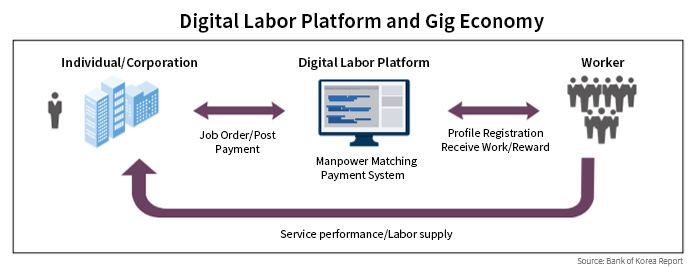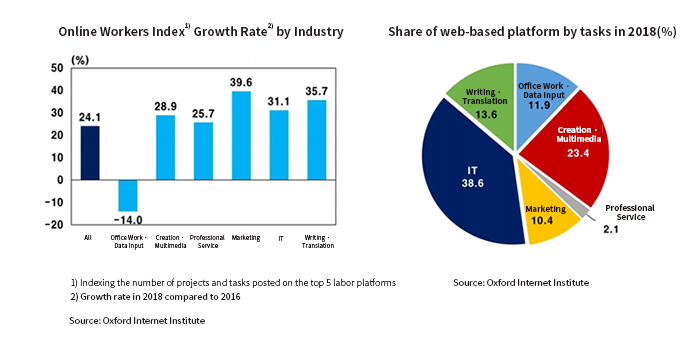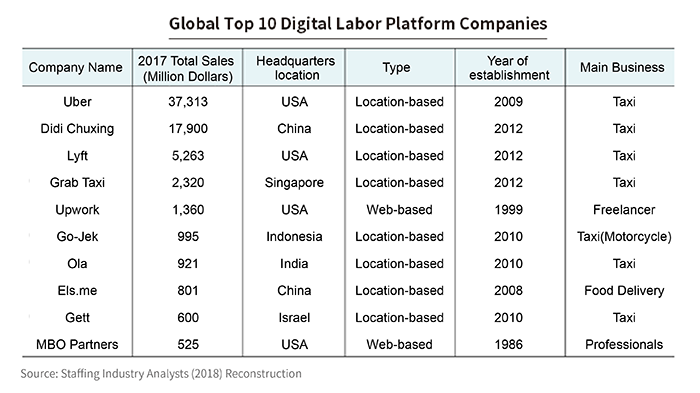The Magazine of Human Resource Management Gig Worker - Who are they?
페이지 정보

작성일 20-05-03 00:00 노출일자 20-05-03
본문
A South Korean portal site surveyed 1,800 workers whether they were working for their first job and the results of the survey showed that only 12.4% still worked for their first job and 87.6% left their first jobs. A lifetime workplace has become an invalid term, and many changes have occurred in modern people’s work patterns. More people work without being affiliated to one place. They are called “Gig Workers”. To know who the gig workers are, it is necessary to understand “Gig” first.
In the 1920s, jazz theaters in the United States hired musicians on a short-term contract to perform. The performance was called gig. By borrowing this word, Gig Economy means an economic phenomenon of hiring temporary workers depending on the needs of companies in a rapidly changing era, such as the 4th Industrial Revolution. Gig was mainly used to refer to temporary workers such as developers and designers in the IT industry. The meaning of it has been expanded to all industrial domains.
Gig Economy is also related to the on-demand economy, which is an economic system that provides services and goods through online or mobile networks according to the demand of consumers. As the on-demand economy is expanding, there is an increasing demand for a workforce capable of providing services to customers. It is believed that gig workers are the proper working type for this.
What is a Gig Worker?
A gig worker means a worker who provides short-term work, such as a short term contract worker or a temporary worker, depending on the needs of an employer. It is different from the existing short-term work type because the mediation of the labor force is done on the digital platform. As the sharing economy based on a digital platform is expanding, single-party contractors such as drivers of car-sharing and couriers belong to this type. This field of business started from vehicles and lodging and had expanded to simple labor services such as delivery and cleaning. It has recently evolved into a service involving professional personnel such as lawyers and consultants.
They work at the desired time and receive a fee for each project (case) without being affiliated to a specific organization based on a smartphone application as long as they meet certain qualifications. They have high autonomy in their work because they can adjust their working hours according to their schedules and enjoy life without commuting. More people dream to be gig workers because they can earn as much as they work.

by country/survey method, but is it estimated to be 20 to 30% of the economically active population in the United States and EU. McKinsey, a global consulting firm, predicts that the gig economy will generate $2.7 trillion, which is 2% of the global GDP,
by 2025.
South Korean Gig Worker – Expanding from Simple Labor Services to Professional Skills
Various on-demand services have also emerged in South Korea and operated based on the gig economy: food delivery, renting a parking lot in front of a house, car maintenance, car wash, laundry, and housekeeping. The Korea Employment Information Service began to collect the status of “domestic digital platform workers” from 2018. The survey results showed that the chauffeur service was 24%, the food delivery was 23%, the express delivery was 23%, and the taxi driver was 30%.
The results indicated that South Korea's gig economy is spreading mainly from the side jobs and delivery industry. For example, Kakao built a chauffeur system by hiring drivers and Baemin handles rapidly increasing delivery demand through a short-range delivery system called “Baemin Connect”. Coupang is running a “Coupang Flex”, a general public delivery partner, and it is said that it is popular among young people who want to earn extra income by using non-working hours.
However, the recently emerged millennials show a somewhat different tendency. The millennial generation tends to voluntarily, joyfully, and freely do what they want, rather than being forced to do boring things. Therefore, the gig economy platform is being revitalized. Among the gig economy platforms, “Upwork” has the most users in the world. 'Upwork' is a platform that allows companies to hire the talent they need among freelancers who registered their competences and skills in the platform. It has 12 million registered freelancers and there are more than 3,500 registered skills.

“Kmong” is a similar South Korean platform. The services registered in Kmong are approximately 170,000, including content production, marketing, interpretation and translation, business consulting, and lessons with 20,000 freelancers and 1,050,000 transactions.
As of 2019, the total cumulative transaction amount exceeded KRW 70 billion, and 630,000 people were using the platform. It connects the demand of companies looking for skilled professionals immediately and freelancers with expertise. It is characterized by trading professional skills rather than general services.
It is predicted that the gig economy platform will be used more as a countermeasure to the difficult economic environment and unemployment. However, there are concerns because labor-related laws and systems treat platform workers as individual businesses, not workers.
Overseas Gig Workers – Preparing Social Measure for Employment Stability
The gig economy also started with simple labor-oriented services such as vehicles, lodging, delivery, and cleaning in foreign countries as well. However, it has recently evolved into a service involving professional personnel such as lawyers and consultants.
However, the majority (over 70%) of global platform sales are still in the transportation sector, such as Uber, Didi Chuxing, and Lift. Particularly, Uber recorded a high growth rate with an approximately 100 times increase in net sales over the past five years. Web-based platforms that are not based on a specific area, such as transportation or delivery, are growing mainly around professional services in high-tech and high-skilled sectors.


In recent years, large corporations also directly use gig economy style employment or provide related services through partnerships with startups. As Amazon began to offer “Prime Now”, an express delivery service, Amazon launched “Amazon Flex” service, which utilizes the general public who owns a private vehicle as a delivery agent since 2015 to reduce costs.
Drives participating in Amazon Flex can make $18-25 per hour up to 12 hours a day with a flexible schedule. Wallgreen, a US pharmacy chain, offers a medication delivery service upon the partnership with TaskRabbit, and Costco also provides a grocery delivery service by partnering with Instacart.
However, there are pros and cons to the gig economy service in the world. It is because the views on the gig economy can be divided into “innovation” and “stealing jobs”. One can see this “unprecedented opportunity”, created by the gig economy, positively, but others concern that it damages employment stability since it uses people only when people are needed rather than creating jobs.
As a result, the UK is looking for measures to ensure adequate social protection for gig workers. While exempting up to 2,500 Euros from the profits earned from the sharing economy, a bill was enacted to strengthen the rights of workers in the gig economy.
The United States has changed its administrative interpretation so that the Fair Labor Standards Act can be applied to people who are not classified as workers because they provide services under independent contracts. Japan has also increased tax benefits to embracing gig workers, specified minimum wage levels, and drafted laws to prevent verbal contracts. Germany, which released the “Labor 4.0” report, is looking for ways to reform labor according to digitization.
Gig Worker Schedule Management and Changes in National System
and Corporate Business System
Although the number of workers using the platform is steadily increasing in South Korea, most of the workers in the platform are not enrolled in the four major insurance programs: national pension, health insurance, employment insurance, and workers’ compensation. They also not enjoy the severance benefits, indicating that gig worker's life stability is low. This requires government legal support. We may consider lowering the tax rate on gig economy income as done in developed countries or imposing welfare allotment related to gig workers on platform companies. It is also possible to consider protecting and regulating individuals within the legal framework after having the government and/or a related organization collect lawful taxed from them. For example, it is to legalize the fare from sharing a ride, tax on the profits generated from it, and protect their working environment.
Companies need to come up with plans to make good use of talented gig workers. First of all, it is needed to identify skills an organization lacks so that skilled gig workers can be hired in a timely manner. It is also necessary to establish a system that gets gig workers easily involved in the organization to conduct tasks effectively. When full-time employees work with freelancers, they often complain that they had to do it all over again. It is because freelancers have poor understanding n the organization and work-related communication is not smooth. Companies shall clearly present the roles of gig workers and provide a system for them to collaborate well with the employees of the company. The force driving gig workers is essentially different from the conventional workers, so it is necessary to reflect the desired working hours, environment, and work autonomy.
Gig workers also need to prepare for themselves. One of the gig workers’ concerns is irregular income. Regular employees can receive a stable salary if they go to work on time and perform given tasks, but gig workers need to organize their time well to generate stable income. They need to make a good schedule and manage time efficiently. Since gig workers provide labor individually, it is unavoidable for them to have limited wage bargaining power compared to organized workers in traditional industries. Additionally, since there is no guaranteed compensation and they can be fired freely, an individual’s work schedule management is also important in the era of the gig economy.
One of South Korea’s recent major tasks is job creation. Activation of one-person self-employment can create jobs. South Korea needs to actively prepare for this, because the gig economy will spread faster based on the world-class Internet networks and mobile commerce markets. We look forward to seeing the stable growth of gig workers by preparing appropriate development plans at the government, business, and individual levels.
Written by Mi-Ran YU, Director, Consulting Biz Unit (mryu@e-hcg.com)
- 이전글Era of Employee Experience 노출일자:20-02-03
- 다음글SMART WORK, Crisis breeds opportunity 노출일자:20-12-01
